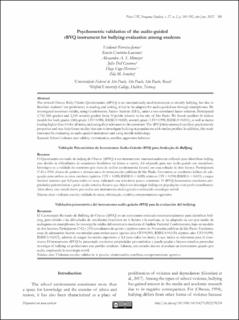| dc.contributor.author | Ferreira, Valdemir | |
| dc.contributor.author | Coutinho-Lourenco, Fausto | |
| dc.contributor.author | Menezes, Alessandra A. S. | |
| dc.contributor.author | Gusmoes, Julia Dell | |
| dc.contributor.author | Cogo-Moreira, Hugo | |
| dc.contributor.author | Sanchez, Zila M. | |
| dc.date.accessioned | 2023-04-05T10:35:22Z | |
| dc.date.available | 2023-04-05T10:35:22Z | |
| dc.date.created | 2022-11-25T13:56:26Z | |
| dc.date.issued | 2022 | |
| dc.identifier.citation | Psico-USF. 2022, 27 (2), 381–392. | en_US |
| dc.identifier.issn | 1413-8271 | |
| dc.identifier.uri | https://hdl.handle.net/11250/3062212 | |
| dc.description.abstract | The revised Olweus Bully/Victim Questionnaire (rBVQ) is an internationally used instrument to identify bullying, but due to Brazilian students’ low proficiency in reading and writing, it had to be adapted for audio-guided use through smartphones. We investigated construct validity, using Confirmatory Factor Analysis (CFA), under a two-correlated factor solution. Participated 1,742 fifth graders and 2,316 seventh graders from 30 public schools in the city of São Paulo. We found excellent fit indices models for both grades (fifth grade: CFI=0.985, RMSEA=0.020; seventh grade: CFI=0.990, RMSEA=0.015), as well as factor loading higher than 0.4 for all items, indicating their relevance to the construct. The rBVQ demonstrated excellent psychometric properties and may help future studies that aim to investigate bullying in populations with similar profiles. In addition, this study innovates by evaluating an audio-guided instrument and using mobile technology. | en_US |
| dc.description.abstract | El Cuestionario Revisado de Bullying de Olweus (rBVQ) es un instrumento utilizado internacionalmente para identificar bullying, pero debido a las dificultades de estudiantes brasileños en la lectura y la escritura, se ha adaptado su uso por medio de audioguías en smartphones. Se investigó la validez del constructo mediante el Análisis Factorial Confirmatorio, bajo un modelo de dos factores. Participaron 1742 y 2316 estudiantes de quinto y séptimo curso de 30 escuelas públicas de São Paulo. Excelentes tasas de adecuación fueron encontradas para ambos casos (quinto año: CFI=0,985, RMSEA=0,020; séptimo año: CFI=0,990, RMSEA=0,015), además de cargas factoriales superiores a 0,4 para todos los ítems, lo que indica su relevancia para el constructo. El instrumento rBVQ ha presentado excelentes propiedades psicométricas y puede ayudar a futuros estudios pretendan investigar el bullying en poblaciones con perfiles similares. Además, este estudio innova al evaluar un instrumento guiado por audio, empleando la tecnología móvil. | en_US |
| dc.language.iso | eng | en_US |
| dc.publisher | Universidade São Francisco | en_US |
| dc.rights | Navngivelse 4.0 Internasjonal | * |
| dc.rights.uri | http://creativecommons.org/licenses/by/4.0/deed.no | * |
| dc.subject | school violence | en_US |
| dc.subject | test validity | en_US |
| dc.subject | victimization | en_US |
| dc.subject | conflict | en_US |
| dc.subject | aggressive behavior | en_US |
| dc.title | Psychometric validation of the audio-guided rBVQ instrument for bullying evaluation among students | en_US |
| dc.title.alternative | Validação Psicométrica do Instrumento Áudio-Guiado rBVQ para Avaliação de Bullying | en_US |
| dc.title.alternative | Validación psicométrica del instrumento audio guiado rBVQ para la evaluación del bullying | en_US |
| dc.type | Journal article | en_US |
| dc.description.version | publishedVersion | en_US |
| dc.subject.nsi | VDP::Samfunnsvitenskap: 200::Pedagogiske fag: 280 | en_US |
| dc.source.pagenumber | 381–392 | en_US |
| dc.source.volume | 27 | en_US |
| dc.source.journal | Psico-USF | en_US |
| dc.source.issue | 2 | en_US |
| dc.identifier.doi | 10.1590/1413-82712022270214 | |
| dc.identifier.cristin | 2081172 | |
| cristin.ispublished | true | |
| cristin.fulltext | original | |

